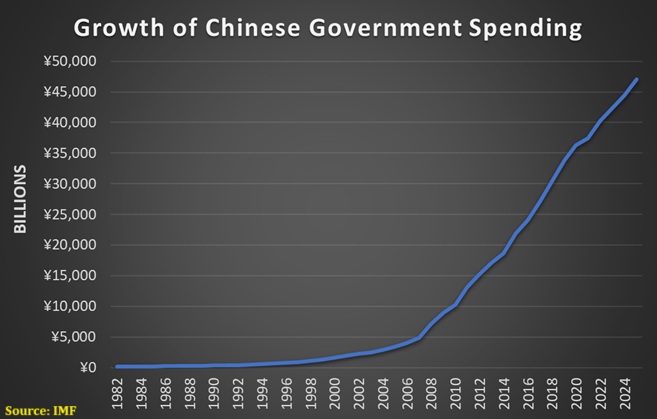I’ve expressed admiration for China’s partial economic liberalization and the impressive growth it produced.
But I’ve also warned that there are some misguided government policies that will make it very difficult for China to become a rich country. I’ve been especially concerned about industrial policy and other types of cronyism.
However, I may need to worry about fiscal policy as well. Teaching earlier today in Shenyang, China, I shared this chart with a group of students.
It shows, based on the IMF’s big database, that government spending has increased dramatically over the past 40-plus years.
This chart looks terrible, but it’s also misleading.
The best measure of a government’s fiscal burden is to compare the size of the budget to the size of the private sector (in other words, government spending as a share of GDP).
On this basis, you immediately notice that China’s fiscal policy was very good for almost 15 years, with the burden of government dropping to about 11 percent of GDP in 1996 (better than Singapore or Hong Kong!).

Unfortunately, that positive trend was only temporary. Since the mid-1990s, the burden of government has been on an upward trajectory.
Indeed, government now consumes more than one-third of the economy’s output, more than three times greater than in 1996.
At the risk of understatement, this eventually will lead to fiscal crisis. Especially when you consider China’s demographic challenge. A clear example of my 20th Theorem of Government.
For wonky readers who want even more data, the next chart provides a breakdown of average spending growth during the 1982-1996 and 1997-2025 periods.
Interestingly, the main difference between the two periods is not the average annual growth of the budget (13.9 percent compared to 15.4 percent). Instead, it is the growth rate of the economy.
For the 1982-1996 period, the private sector was growing faster than the government (fulfilling the Golden Rule). That’s when progress occurred.
Sadly, but that relationship reversed starting in 1997.

By the way, these are all nominal numbers, meaning they are not adjusted for inflation. So I also show the average inflation rate for the two periods on the right side of the chart.
Notice that the burden of government has grown faster than the economy during the 1997-2025 period, and also that the budget has grown far faster than inflation.
The moral of the story is that China should enact a spending cap.
P.S. Some economists believe Chinese government data is untrustworthy, but presumably any corrections would not change the fact that fiscal policy has been moving in the wrong direction.
———
Image credit: wuwow | Pixabay License.
Click this link for the original source of this article.
Author: Dan Mitchell
This content is courtesy of, and owned and copyrighted by, https://freedomandprosperity.org and its author. This content is made available by use of the public RSS feed offered by the host site and is used for educational purposes only. If you are the author or represent the host site and would like this content removed now and in the future, please contact USSANews.com using the email address in the Contact page found in the website menu.









